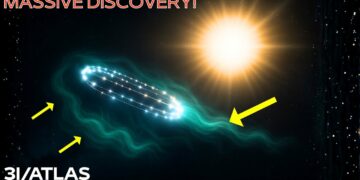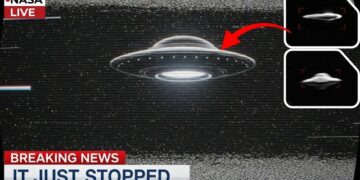NASA’s James Webb Space Telescope (JWST) has captured the deepest images of the universe ever seen, revealing a discovery that challenges the foundations of astrophysics. Peering into a distant region of space, where light from the early universe—emitted shortly after the Big Bang—still lingers, JWST’s infrared sensors uncovered an enormous, fully mature galaxy that defies cosmological models. This galaxy, with its structured spiral arms and luminous core, existed less than 400 million years after the Big Bang, far too early for such a complex and organized structure to have formed according to standard theories.
This finding upends our understanding of the early universe, which was expected to be a chaotic mix of particles and radiation, with only small, irregular galaxies forming. The presence of this galaxy suggests either an accelerated evolutionary process or an entirely new mechanism of galaxy formation. Its chemical composition, rich in heavy elements like carbon, oxygen, and iron—typically forged in stars over billions of years—implies that stellar nucleosynthesis occurred far faster or through unknown processes. This challenges the timeline of cosmic evolution and raises questions about the role of dark matter, the interpretation of redshift, or even the possibility of new physics, such as modified gravity or influences from parallel universes.
Further observations revealed more such galaxies, each too large, luminous, and structured for their era. Their light signatures showed unexpected dynamism, with fluctuations suggesting active galactic nuclei or quasars powered by supermassive black holes—entities thought to form much later. The galaxy’s stable, barred spiral structure and intense gravitational field, inconsistent with typical dark matter halos, hint at novel gravitational interactions or an unknown state of matter. Its isolation, free from the usual cosmic web of galactic clusters, adds to the mystery, suggesting a unique formation process.
This discovery also impacts astrobiology. The early presence of complex galaxies with rich chemistry extends the potential window for planet formation and life, possibly billions of years earlier than Earth’s formation. JWST’s high-resolution imaging mapped star-forming regions and gas flows within the galaxy, revealing a universe far more mature and active than expected. The telescope’s polarimetry detected twisted light patterns, possibly indicating chiral particle interactions, which could suggest a universal asymmetry influencing the origins of life.
As more anomalous galaxies emerged, they pointed to a hidden cosmic architecture. Background energy fluctuations, inconsistent with known radiation, and synchronized starburst activity across galaxies hint at unknown quantum fields or relic cosmic structures. Theories like cosmic time bubbles, where time flows differently, or the holographic principle, where the universe is a projection of deeper information, are gaining traction. These findings suggest the universe may be a mosaic of regions with varying physical laws, challenging the uniformity of cosmic evolution.
JWST’s data has sparked a scientific revolution, forcing a re-examination of cosmology, from inflation theory to gravitational wave models. The telescope’s sensitivity may even be detecting phenomena beyond the electromagnetic spectrum, such as imprints from previous cosmic cycles. These discoveries, dubbed “cosmic archaeology,” reveal a universe not just vast but intricately complex, with secrets embedded in its structure. Far from providing answers, JWST has unveiled a cosmos that defies comprehension, reminding us that the impossible may simply be the undiscovered. As researchers continue to analyze this data, the universe appears not as a solved puzzle but as a dynamic, mysterious expanse, rekindling the essence of scientific exploration.























